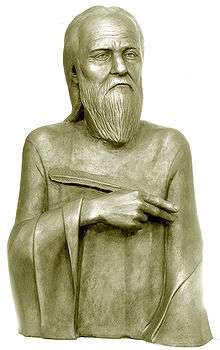Nestor the Chronicler
| Nestor the Chronicler | |
|---|---|
 Forensic facial reconstruction by Sergei Nikitin. | |
| Born | The middle of the 11th century |
| Died | The beginning of the 12th century |
| Occupation | monk |
| Known for | compilation of Primary Chronicle |

Saint Nestor the Chronicler (c. 1056 – c. 1114, in Kiev, modern-day Ukraine) was the reputed author of the Primary Chronicle, (the earliest East Slavic chronicle), Life of the Venerable Theodosius of the Kiev Caves, and Account about the Life and Martyrdom of the Blessed Passion Bearers Boris and Gleb.
In 1073, Nestor became a monk of the Monastery of the Caves in Kiev. The only other detail of his life that is reliably known is that he was commissioned with two other monks to find the relics of St. Theodosius of Kiev, a mission which he fulfilled successfully. It is also speculated that he supported the reigning prince Svyatopolk II, and his pro-Scandinavian party disliked Greek influence in Kiev.
His chronicle begins with the Deluge, as did those of most Christian chroniclers of the time. The compiler appears to have been acquainted with the Byzantine historians; he makes use especially of John Malalas and George Hamartolus. He also likely had other Slavonic language chronicles to compile from, which have since been lost. Many legends are mistakenly attributed to Nestor's Chronicle; the style is occasionally so poetic that perhaps he incorporated bylinas that are now lost.
As an eyewitness, Nestor could only have described the reigns of Vsevolod I and Svyatopolk II (1078–1112), but it is surmised he could have gathered many details from older inhabitants. Two such possibilities are Giurata Rogovich of Novgorod, who could have provided him with information concerning the north of Rus', the Pechora River, and other places, as well as Yan Vyshatich, a nobleman who died in 1106 at the age of ninety. Nestor provided valuable ethnological details of various Slavic tribes.
The current theory about Nestor is that the Chronicle is a patchwork of many fragments of chronicles, and that the name of Nestor was attached to it because he either wrote the majority of it or was responsible for piecing all the fragments together. The name of the hegumen Sylvester is affixed to several of the manuscripts as the author.
Historian Sergey Solovyov remarked that Nestor cannot be called the earliest Russian chronicler, but he is the first writer who offered a national perspective in his history, the others being merely local writers. The language of his work, as shown in the earliest manuscripts just mentioned, is Palaeo-Slavonic with many examples of Russianism.[1]
St. Nestor died around 1114 and was buried in the Near Caves. He has been glorified (canonized) as a saint by the Russian Orthodox Church. The body of the ancient chronicler may be seen among the relics preserved in the Kiev Pechersk Lavra. His feast day is celebrated on October 27. He is also commemorated in common with other saints of the Kiev Caves Lavra on September 28 (Synaxis of the Venerable Fathers of the Kiev Caves) and on the Second Sunday of Great Lent.
Known works
- Life of the Venerable Theodosius of the Kiev Caves (1080s)[2]
- Primary Chronicle, or The Tale of Bygone Years (ca. 1113)
- Account about the Life and Martyrdom of the Blessed Passion Bearers Boris and Gleb (1080s)[3]
Notes
- ↑ Llc, Books (2017-02-11). Russian Historians: Mikhail Lomonosov, Elena Filatova, Viktor Suvorov, Andrey Korotayev, Neo-Stalinism, Yuri Knorozov, Leo Klejn, Sergey Zagraevsky, Yevgeny Tarle, Aleksandr Reshideovich Dyukov, Boris Petrovich Polevoy, Vladimir N. Beneshevich. General Books LLC. ISBN 9781157415800.
- ↑ "Saint Nestor the Chronicler" (PDF). St. Luke Greek Orthodox Church. Retrieved 19 March 2017.
- ↑ "Venerable Nestor the Chronicler of the Kiev Caves". Orthodox Church in America. Retrieved 19 March 2017.
References
 This article incorporates text from a publication now in the public domain: Chisholm, Hugh, ed. (1911). "Nestor (author)". Encyclopædia Britannica. 19 (11th ed.). Cambridge University Press. p. 406, 407.
This article incorporates text from a publication now in the public domain: Chisholm, Hugh, ed. (1911). "Nestor (author)". Encyclopædia Britannica. 19 (11th ed.). Cambridge University Press. p. 406, 407.
External links
 Media related to Nestor the Chronicler at Wikimedia Commons
Media related to Nestor the Chronicler at Wikimedia Commons- Russian text of the chronicle
- Venerable Nestor the Chronicler of the Kiev Near Caves Orthodox icon and synaxarion
- Visitor information for Kiev Pechersk Lavra